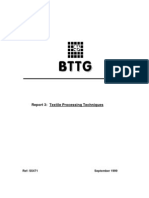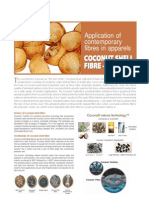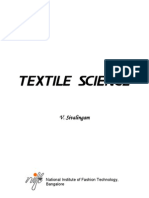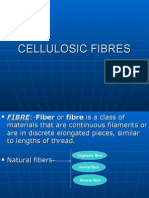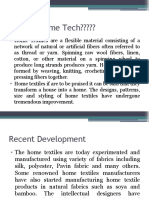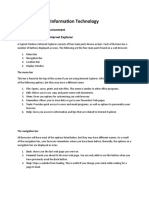Basic Textiles Study
Uploaded by
Maria ElizabethBasic Textiles Study
Uploaded by
Maria ElizabethINTRODUCTION TO TEXILES
Clothing is part of the primary needs of man and these is gotten from textiles fibres and fabrics.
Therefore, the study of textile is very important.
Textile or cloth is defined as a flexible woven material consisting of both natural and artificial
fibres which are often referred to as thread. Examples are: cotton, wool, rubber etc.
BASIC TEXTILE TERMS.
i. FABRIC: They are clothes that are gotten from processing yarns into yards or bundles of beautiful
materials.
ii. FIBRE: They are the basic or smallest unit of a fabric. They are also used in the production of yarn.
iii. YARN: This is a collection of fibres which are twisted together to form a thread. They are threads
used in the weaving or knitting of fabrics in textile mills.
iv. GRAINS: It is referred to as the position of warp yarns in relation to filling yarns in fabrics.
v. WARPS: They are threads that runs lengthwise or horizontally on a woven thread.
vi. WEFTS: They are the threads that runs across the warp threads on a woven fabric. Also, they can be
said to run vertically.
vii. SELVEDGE: It is a long-finished edge of a fabric.
viii. WEAVING: This is the way of interlacing the two set threads. (i.e the wefts and the warps).
ix. BIAS BINDING: this is a narrow strip of fabric cut in a slanting way and used to bind edges for
decoration and to give strength to the materials.
WHY TEXTILE STUDY
1. It helps us to know the origin of fibres, their properties and their uses.
2. It helps us to know the different textiles for different occasions and seasons.
3. It helps consumers to make wise decision.
4. It helps us know the benefits of choosing a career in clothing and textile.
5. It each everyone how to handle and care for each textile appropriately.
6. It helps fashion designers to be able to understand information on how to deal with different textile
materials during sewing.
7. It helps people to interprete information on clothe.
GENERAL USES OF TEXTILE
1. It is used for making house furnishings e.g. carpets, rug, upholstery.
2. It is used in making household linen like bedsheets, curtains etc.
3. It is used for making clothes.
4. It is used to keep the body warm.
5. It is used for beautification.
6. They are used for making nets and tents.
7. They are used for making accessories like bags, shoes, jewelries, etc.
8. They are used in making sport wear.
9. They are used for making decorations and making canopies, tents, flags, nets, etc.
10. They are used for medical materials such as bandages, cotton wool, plasters, etc.
FABRIC CONSTRUCTION METHODS
1. WEAVING: Is the process of interlacing warp weft yarns at right angles.
2. KNITTING: This the process of constructing fabric by forming rows of loops.
3. CROCHETING: Process of constructing fabric by making a chain of loops from a single yarn.
4. KNITTING
5. BRAIDING.
CLASSES, PROPERTIES AND CARE OF FIBRE
Fibres are divided into two types, namely-;
1. Natural fibre
2. Synthetic(man-made) fibre
Fibres
Natural Fibres Synthetic Fibres
Animal Fibres Vegetable (Plant) Fibres Cellulose Based Non Cellulose
Example: 1. Wool 1. Cotton (cotton balls) 1. Crayon 1. Nylon
2. Silk 2.Linen 2. Acetate 2. Polyester.
You might also like
- PDF Crochet Mr. Beans Teddy Amigurumi Free Pattern64% (11)PDF Crochet Mr. Beans Teddy Amigurumi Free Pattern7 pages
- Textile Structures For Technical TextilesNo ratings yetTextile Structures For Technical Textiles10 pages
- Application of Contemporary Fibres in Apparels Cocona Fiber100% (1)Application of Contemporary Fibres in Apparels Cocona Fiber4 pages
- Preparation, Packaging and Marketing of Food Items67% (3)Preparation, Packaging and Marketing of Food Items5 pages
- Volpintesta L The Language of Fashion Design 26 Principles e97% (39)Volpintesta L The Language of Fashion Design 26 Principles e227 pages
- Textile - Fibre To Fabric Processing: Chapter - 3No ratings yetTextile - Fibre To Fabric Processing: Chapter - 341 pages
- Chemical Spinning: - Wet Spinning - Dry Spinning - Melt SpinningNo ratings yetChemical Spinning: - Wet Spinning - Dry Spinning - Melt Spinning5 pages
- GATE Textile Fibres Study Material Book 3 Textile FibresNo ratings yetGATE Textile Fibres Study Material Book 3 Textile Fibres9 pages
- Agrotextiles - Study Material - 8th Semester BTech - 2023100% (1)Agrotextiles - Study Material - 8th Semester BTech - 202327 pages
- Use of Enzymes in Textile Wet ProcessingNo ratings yetUse of Enzymes in Textile Wet Processing6 pages
- Chapter 3 Fabric Properties and Their Characteristics - Symplectic PDFNo ratings yetChapter 3 Fabric Properties and Their Characteristics - Symplectic PDF46 pages
- 1stTermGrade9HomeEconomicsNote2024zrws6c40No ratings yet1stTermGrade9HomeEconomicsNote2024zrws6c4058 pages
- Information Technology: Web/Internet BrowserNo ratings yetInformation Technology: Web/Internet Browser3 pages
- 1-Gun Drill Machine Drills Quotations Comparison-With Coated-1No ratings yet1-Gun Drill Machine Drills Quotations Comparison-With Coated-14 pages
- Easel Painting - : Contemporary Philippine Arts From The Region: LESSON 2-4100% (2)Easel Painting - : Contemporary Philippine Arts From The Region: LESSON 2-45 pages
- The Encyclopedia of Origami and Papercraft Techniques - 1st Edition (1995)100% (2)The Encyclopedia of Origami and Papercraft Techniques - 1st Edition (1995)258 pages
- Husqvarna/Viking Victoria Sewing Machine Instruction Manual0% (1)Husqvarna/Viking Victoria Sewing Machine Instruction Manual42 pages
- massive-crochet-64e7cde5929a24-12329118-51129429No ratings yetmassive-crochet-64e7cde5929a24-12329118-511294293 pages
- Curlworks'4-Finger Toony Puffy Paw Pattern: MaterialsNo ratings yetCurlworks'4-Finger Toony Puffy Paw Pattern: Materials3 pages
- Kenmore 385.4052/janome LX200 Sewing Machine Instruction ManualNo ratings yetKenmore 385.4052/janome LX200 Sewing Machine Instruction Manual77 pages
- Francais The Crochet Puffin PDF Amigurumi Free Pattern100% (3)Francais The Crochet Puffin PDF Amigurumi Free Pattern5 pages
- Anton Seder - Art Nouveau_ Objects and Artifacts-Courier Dover Publications (2015)(Z-Lib.io)No ratings yetAnton Seder - Art Nouveau_ Objects and Artifacts-Courier Dover Publications (2015)(Z-Lib.io)58 pages
- Crochet Unicorn Amigurumi Pattern - Craft PassionNo ratings yetCrochet Unicorn Amigurumi Pattern - Craft Passion36 pages
- Icm Fullxfull.364140118 Siwn0wfbutc4k8wg4kcc100% (1)Icm Fullxfull.364140118 Siwn0wfbutc4k8wg4kcc17 pages





